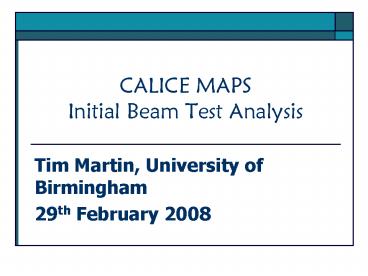CALICE MAPS Initial Beam Test Analysis - PowerPoint PPT Presentation
Title:
CALICE MAPS Initial Beam Test Analysis
Description:
Any noisy pixel can fill up it's regions 19 SRAM registers within a few thousand bunch trains. ... No evidence of SRAM buffers filling up. Dead Just Here ... – PowerPoint PPT presentation
Number of Views:23
Avg rating:3.0/5.0
Title: CALICE MAPS Initial Beam Test Analysis
1
CALICE MAPSInitial Beam Test Analysis
- Tim Martin, University of Birmingham
- 29th February 2008
2
Data File Used
- Using Run 490084
- mpsBeamThresholdScan
- 1.3M BunchTrains (only used first million)
- 3 GeV e-, No W plates
- Take Shapers on S2 S8
- Only when Threshold120 on BOTH -gt 500,000
bunch trains
3
(No Transcript)
4
Noise elimination
- Any noisy pixel can fill up its regions 19 SRAM
registers within a few thousand bunch trains. - Kill all regions with pixels firing at a averaged
rate greater than 10-4 per bunch train.
5
Noise map of the two sensors. Linear scale so
only the very worst pixels are showing here.
Generated from 490083 run. Threshold, no beam,
252k bunch trains.
6
Procedure
- Look for timestamps with gt1 hit
- Find all clusters in the sensor at that timestamp
- Do for second sensor
- If gt0 clusters in each sensor then match the
clusters to minimise separation.
7
All happening in 1 timestamp
S2
S2
Algorithm matches clusters with minimum separation
This event would result in 1 unmatched cluster in
S2
S8
8
Find all pixels less than 6 pixels away from Seed
Dead Region
1.
3.
Cluster Seed -
2.
Remove the pixels making up this cluster and
repeat until N Pixels lt 2
9
Some Run Stats
N BUNCH TRAINS 997,592 Useable Bunch Trains
541,592 N Unmatched S2 Clusters 119,765 N
Unmatched S8 Clusters 133,723 NTrackThroughs
4,549 Average 3.7 Cluster Match Efficiency N
Events Where Pixels Found but No Cluster in S2
6,750 N Events Where Pixels Found but No Cluster
in S8 7,524 N Timestamps with gt0 Clusters in
(S2) 123,086 N Timestamps with gt0 Clusters in
(S2) 137,004 Cluster found a sensor in (on
average) 24 of Bunch Trains
10
Quick noise check
- Run 490085
- Another Threshold, no beam
- Ran analysis, 154k trains (82,000 useable bunch
trains). - Using our noise map from run 83
- Saw total of 52 clusters in both sensors no
trackthroughs excellent!
11
(No Transcript)
12
(No Transcript)
13
Cluster offset between layers peaks at (3,4)
pixels with respect to Sensor 2s coordinate
system. Due to board alignment?
14
Magnitude of separation peaks at 3 pixels. Small
tail still present up to large separation. Note
log x scale
15
Finding multiple clusters in a sensor at a
timestamp does not appear as rare as I would have
thought.
16
Number of pixels firing per cluster
17
Clusters appear evenly spread over all
timestamps. No evidence of SRAM buffers filling
up.
18
Dead Just Here 11.86 Dead Both 6.02 Alive
Just Here 20.37 Alive Both
55.89 OutOfBounds 5.87
Dead Just Here 20.36 Dead Both 6.02 Alive
Just Here 11.86 Alive Both
55.89 OutOfBounds 5.87
19
Conclusion
- Looking for clusters dramatically cuts down on
sensor noise. - Using a noise map practically eliminates
misbehaving pixels at the expense of whole
regions. - Multiple clusters within a timestamp is not
understood. Could the PMT scintillator be
affecting the beam? - Evidence of particles passing through the stack
but efficiency still low.































